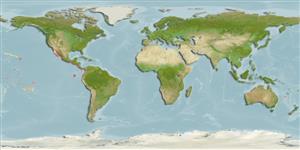Common names from other countries
Environment: milieu / climate zone / depth range / distribution range
Ecologia
marinhas associadas(os) a recifes; intervalo de profundidade 3 - 68 m (Ref. 5227). Tropical
Eastern Pacific: Baja California to Peru, including the Galapagos and other offshore islands.
Tamanho / Peso / Idade
Maturity: Lm ? range ? - ? cm
Max length : 28.0 cm TL macho/indeterminado; (Ref. 5227)
Descrição breve
Chaves de identificação | Morfologia | Morfometria
Espinhos dorsais (total) : 3; Raios dorsais moles (total) : 23 - 26; Raios anais moles: 16 - 18; Vértebras: 24. Sides of body, excluding cheeks, mottled with cream to pale-brown blotches on dark background, reaching onto bases of median fins; blotches are poorly-defined and often coalescing. Body and head, excluding lips and maxillary, with embedded scales. Dorsal spines 3 (rarely 2). Lower jaw projecting, with prominent fleshy protuberance. Numerous, small pores, in patches, along ventral surface of lower jaw and on the free-edge of preopercle in > 6.5 cm SL specimens (Ref. 40934).
Lives in rocky reefs, sheltering in caves and crevices but also encountered in the open (Ref. 11482). Lies motionless, often on its side, hidden in dark recesses. Actively hunts at night, preying on small fish (Ref. 5227).
Life cycle and mating behavior
Maturities | Reprodução | Spawnings | Egg(s) | Fecundities | Larvas
Allen, G.R. and D.R. Robertson, 1994. Fishes of the tropical eastern Pacific. University of Hawaii Press, Honolulu. 332 p. (Ref. 11482)
Categoria na Lista Vermelha da IUCN (Ref. 130435)
CITES (Ref. 128078)
Not Evaluated
Ameaça para o homem
Harmless
Utilização humana
Ferramentas
Relatórios especiais
Descarregue XML
Fontes da internet
Estimates based on models
Preferred temperature (Ref.
115969): 20.6 - 28.9, mean 25.9 (based on 82 cells).
Phylogenetic diversity index (Ref.
82804): PD
50 = 0.5010 [Uniqueness, from 0.5 = low to 2.0 = high].
Bayesian length-weight: a=0.01738 (0.00680 - 0.04443), b=3.01 (2.78 - 3.24), in cm Total Length, based on LWR estimates for this (Sub)family-body shape (Ref.
93245).
Nível Trófico (Ref.
69278): 4.0 ±0.7 se; based on size and trophs of closest relatives
Fishing Vulnerability (Ref.
59153): Low vulnerability (18 of 100).
